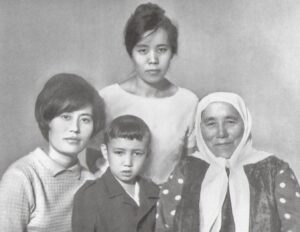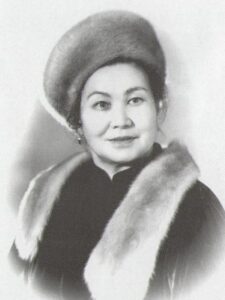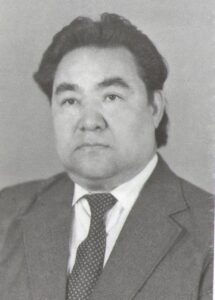Otynshy Alzhanov
The wife of Otynshy Alzhanov – Nurzhamilya Kemengerova (1882-1963)
Otynshy Alzhanov was married to the daughter of Dyuisebai-haji – Nurzhamilya Kemengerova. She was 12 years younger than him. Nurzhamilya’s sibling was the well-known Koshmukhamet Kemengerov. They had four children: one daughter Bibifatima and three sons. The youngest died in infancy. The others – Bibifatima, Mukhamedkasym and Galymzhan are survived. But they had to experience a lot of hardships and difficulties in their lives.
Having remained a widow at the age of 37, Nurzhamilya remained faithful to the memory of her husband. Perhaps Otynshy Alzhanov felt that he would live a short life, because he often said to his wife: “Nurushka, promise me, if something bad happens to me, to invest all money in education of our children”. After his death, she did everything as he bequeathed to her. Great help in preserving the Otynshy family was provided by his own sister Bykiya. Until the last days she was next to Nurzhamilya. Nurzhamilya lived where her children could study. First, they studied at the Lepsinsky 3-grade school, then at the 2-grade male school.
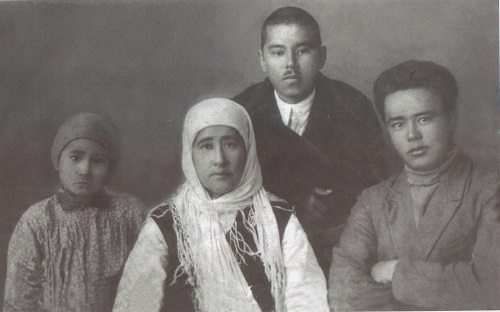
The son of Otynshy Alzhanov – Mukhamedkassym
The eldest son Mukhamedkassym (Mukash), after graduating from the gymnasium in Zaisan, entered the course of financiers in Omsk and worked in this specialty until the end of his days. Two daughters Nursagilya and Saule were born in a marriage with Gulshakar. Nursagylya in marriage with A. Tulebaev (the brother of Mukan Tulebaev), gave birth to two sons – Aidar and Anuar, four daughters: Maira, Dina, Bakhyt and Gulya.
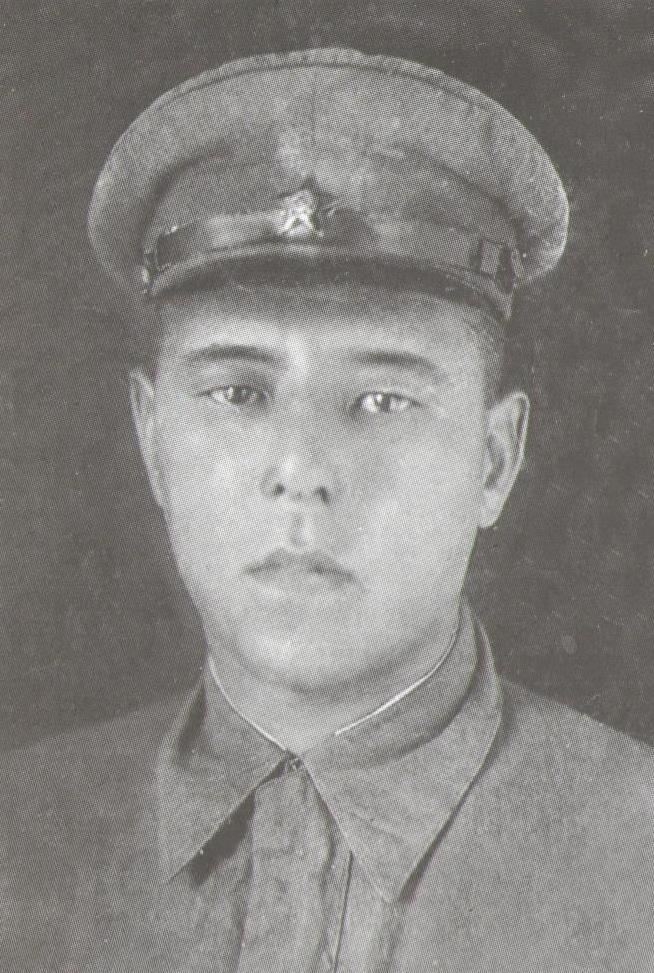
The daughter of Otynshy Alzhanov – Bibifatima (1902-1983)
Bibifatima gave birth to two sons – Ertai and Zamanbek, as well as two daughters – Khamida and Rosa. Bibifatima’s son Ertai Tulemisov was an academician of pedagogical sciences, head of the department of pedagogy and psychology.
Ertai Tulemisov married to Saule, they had two daughters – Gulfarida and Laura. Saule Tulemisova defended PhD of candidate of economic sciences. In the late 50s – early 60s, she was deputy chairman of the City Executive Committee (deputy akim) of the city of Aktobe, head of the industry department of the Ministry of Finance of the Kazakh SSR, dean of the Faculty of Economics of the Kazakh Polytechnic Institute, deputy party secretary of KazPTI named after V.I.Lenin.
The son of Otynshy Alzhanov – Galymzhan (1909-1965)
The second son Galymzhan after graduation high school he entered Tashkent Agricultural Institute and finished it in 1936. Then he entered Leningrad University at the Faculty of Oriental Studies. Here he had time to study together with his friend and countryman Alkei Margulan only 2 years. They lived together in one room of hostel till 1938. Precisely in this year he was persecuted by the People’s Commissariat of Internal Affairs as the son of member of Alash-Orda government. Galymzhan was assigned a stamp “the enemy of people” and was exiled to Tashkent. Conditions of travel were terrible. All exiles starved and suffered from December’s cold. People were died on the way. At each stop, overseers came and took out the corpses of the dead, and the seriously ill were left at the station. Galymzhan reached up to the station Chelkar of Orenburg railway, where in semiconscious state he was thrown off the train by overseers, having said him last parting words: “If you want to live – go to the police and register”. Helplessly sitting on the ground, he was seen by the driver of the steam locomotive of this station P. Taran, who was returning from another trip. He noticed a young, intelligently but dirty dressed up and helplessly looking around Kazakh guy. It was clear that he was not from this place and that he was very ill. Petr Taran left Galymzhan in his home until he got well and registered in PCIA agency and got a job. This father’s care as Galymzhan called, he remember all his life.
Here in Chelkar he became work as an agronomist and in 1941 he was already chief agronomist in district agricultural department of Chelkar district. However the status “exiled” which invariably stand near his surname, always mobilized workers of PCIA to be vigilant of his personality. As if he was an exile he was not taken to the front, not even trusting the defense of the Fatherland. Moreover in harsh 1943 activists of PCIA decided to send his in farther region as a political exile, to Uil village, however as a specialist he has established itself in good side in Chelkar district. It was not even normal transport connection with regional center. Only once a week truck brought and took away local post and bosses. Here he worked until in 1953 after death of Stalin was accepted general amnesty, up to political. As agronomist he tried to be propagandist innovative methods of housekeeping in their field. So being a chief agronomist Uilsk district of Aktobe region, he bred a new variety of white millet, for the breeding of which he was not even allowed to have authorship. Therefore a man Chaganak Bersiev was supposedly a breeder. G. Alzhanov wrote a book about this man, which brought him fame as a publicist. For knowledge of breeding work in millet in 1950-1955, Galymzhan Alzhanov was appointed head of the agricultural pavilion of the Kazakh SSR at the All-Union Exhibition in Moscow. Here he carried out a great propaganda work on the agriculture of the Kazakh SSR. Later, for his publicistic work, he was awarded the title of a member of the Union of Journalists of the USSR.
Outwardly, Galymzhan Alzhanov, as his mother said, looked like his father. He was also tall, stately, with a handsome noble face, with a cheerful disposition and a clear mind. Galymzhan Alzhanov had five children: two sons – Alkei and Rakhan, three daughters – Assiya, Nurila and Khalida.
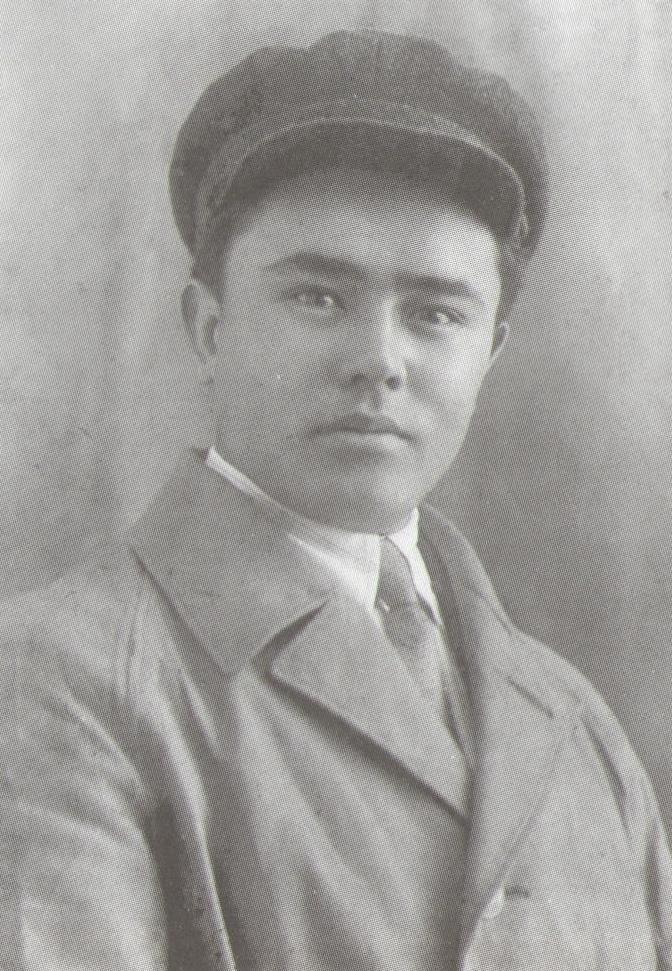
Bibliography
- Alzhanova S. Tulemissova G. Golden eagle of Alash-Orda, the Fund of Altynbek Sarsenbaiuly, 2008.-180.
Internet resources
